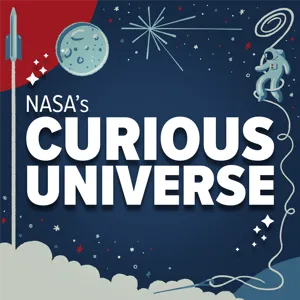Podcast Summary
New images from the James Webb Space Telescope reveal the universe's hidden beauty: The James Webb Space Telescope's initial images offer unprecedented sharpness and clarity, revealing new details about distant galaxies, a dying star, and a stellar nursery, leaving scientists in awe and excited for future discoveries.
The James Webb Space Telescope, NASA's newest and most powerful deep space telescope, has recently provided stunning images of the universe, including a galaxy that is over 13 billion light-years away. These images, which include a stellar nursery, a dying star, and multiple galaxies, offer a sharpness and clarity never seen before, revealing the hidden structure and beauty of the universe. The scientific community has been left speechless by these initial findings, with some even shedding tears upon seeing the data. The images serve as a reminder of the vastness and complexity of the universe and our small place within it. These first efforts from the telescope only scratch the surface of its capabilities, leaving scientists excited for what is yet to be discovered.
A new era of space exploration with the James Webb Telescope: The James Webb Telescope, set to launch soon, is a major advancement in space technology, capable of observing dimmer, farther objects, even those from the time shortly after the Big Bang, despite its size and inability to be fixed once launched.
The James Webb Telescope, set to launch in the coming years, represents a significant leap forward in space technology. This successor to NASA's Hubble Space Telescope is larger, allowing it to gather more light and observe dimmer, farther objects, even those from the time shortly after the Big Bang. The telescope's size and design necessitate its placement a million miles from Earth, making it impossible to fix once launched. In 1990, Hubble, NASA's previous telescope, faced a major setback when its mirrors were discovered to be ground incorrectly, leading to blurry images. This issue, though eventually resolved with corrective lenses, was a significant embarrassment for NASA. The James Webb Telescope, with its advanced capabilities, is poised to provide unprecedented insights into the universe, effectively allowing us to look back in time.
NASA's James Webb Space Telescope: Extreme Precision and Innovation: NASA's James Webb Space Telescope, with a 21-foot mirror and designed to detect infrared light from the universe's farthest reaches, required extreme precision, a significant budget increase, and innovative engineering to fit its massive components into a rocket and keep it extremely cold.
The successful launch and operation of the James Webb Space Telescope required an unprecedented level of precision and innovation due to its size, the extreme cold required for its operations, and the need to fit its massive components into a rocket. NASA knew that there could be no second chances for errors, as the telescope's complex design and mission objectives demanded perfection from the very beginning. This meant extensive testing and a significant budget increase from the initial estimate. The telescope's mirror is 21 feet in diameter, much larger than Hubble's 8-foot mirror, and its operations rely on detecting infrared light from the farthest reaches of the universe. To achieve this, the telescope had to be kept extremely cold, around minus 380 degrees Fahrenheit, which required a tennis court-sized sunshield and intricate engineering to fit it all into a rocket. The project faced numerous challenges over the years, but the resulting images have been worth the effort, providing unprecedented insights into the universe.
NASA's James Webb Space Telescope Overcomes Challenges to Launch: NASA's most ambitious space project, the James Webb Space Telescope, faced numerous challenges but launched on Christmas day 2021, bringing new insights into the universe and highlighting the importance of perseverance and investment in groundbreaking scientific discoveries.
The James Webb Space Telescope, NASA's most ambitious space observatory project, faced numerous challenges including repeated delays and rising costs, which led to concerns from Congress about canceling the program. However, despite these challenges, NASA persisted and eventually secured the necessary funding to launch the telescope on Christmas day 2021. The telescope, which is on an Ariane 5 Rocket launched from French Guiana, is expected to provide new insights into the universe that have been long-anticipated by astronomers. The project's history serves as a reminder of the importance of perseverance and the significant investment required for groundbreaking scientific discoveries.
New Space Telescope Reveals Unprecedented Images of Universe: The James Webb Space Telescope, with its larger mirror and infrared capabilities, is providing more detailed and colorful observations of the universe, particularly focusing on exoplanets.
The James Webb Space Telescope, recently launched into space, is already starting to reveal new and unprecedented images of the universe. Its larger mirror and ability to detect infrared light allow for more detailed and colorful observations than previous telescopes. Furthermore, the telescope's primary mission is to examine exoplanets, or planets around other stars, which was a major goal even when the telescope was being planned in the 1990s. Despite the complexity of the launch and the need for precise calibration and deployment of the mirror and sunshield, all went smoothly and the instruments are now producing data beyond expectations. This is a significant step forward in our understanding of the universe and the planets beyond our own.
Exploring the possibility of life beyond Earth with the James Webb Space Telescope: The James Webb Space Telescope will revolutionize our understanding of the universe by analyzing the atmospheres of exoplanets for signs of water, oxygen, and other molecules that could indicate the presence of life, starting with those in the TRAPPIST-1 system.
The James Webb Space Telescope represents a major leap forward in our ability to explore the existence of life beyond Earth. By analyzing the atmospheres of exoplanets, scientists can identify potential signs of water, oxygen, and other molecules that could indicate the presence of life. This is particularly exciting for planets like those in the TRAPPIST-1 system, where three Earth-sized planets are located in the habitable zone. With Webb, we can begin to understand the range and diversity of planets in our galaxy and answer fundamental questions about the prevalence of Earth-like worlds. The telescope's capabilities extend beyond just imaging and will provide valuable insights into the possibility of life beyond our own planet. The James Webb Space Telescope is expected to operate for about 10 years, during which it will revolutionize our understanding of the universe and potentially answer some of the most profound questions about our place in it.
NASA's James Webb Space Telescope Surpasses Expectations, Extending Its Lifespan: NASA's James Webb Space Telescope has surpassed expectations, extending its operational lifespan from 10 to at least 20 years. NASA benefits from cost-effective rocket purchases from private companies, while billionaires focus on commercial space travel. NASA and partners continue to explore fundamental cosmic questions.
The James Webb Space Telescope's launch has exceeded expectations, extending its operational lifespan from the initial planned 10 years to at least 20 years. This telescope's success comes at a time when private companies and billionaires have been making significant strides in space travel. NASA is benefiting from these advancements, purchasing rockets instead of developing them in-house, which is more cost-effective for human spaceflight initiatives. However, the billionaires' focus is primarily on commercial space travel, leaving NASA to tackle the scientific questions that fuel human curiosity, such as "Are we alone?" and "Why is there a universe at all?" These missions, which explore the fundamental mysteries of the universe, are not economically viable for private enterprises. Thus, NASA and its international partners remain the primary explorers of the cosmos. Despite the occasional damage from micrometeoroids, the James Webb Space Telescope continues to operate and provide valuable data, even contributing to our understanding of the solar system's composition.
Exploring Space and International Politics: NASA leads space exploration, President Biden emphasizes international importance, Ivana Trump passes away accidentally
Space exploration continues to be an exciting frontier for discovery and exploration, just as centuries ago people explored new continents. NASA is leading the charge in our solar system and universe, and President Biden's recent visit to the Middle East underscores the international importance of this pursuit. Elsewhere, former first lady Ivana Trump, known for her media attention during her marriage to Donald Trump, died at her home in Manhattan, and the cause appeared to be accidental. In the news, President Biden issued a stern warning to Iran regarding nuclear weapons during his visit to Jerusalem, and Ivana Trump passed away at the age of 73. The daily episode was produced, edited, and engineered by various team members, with original music by Marian Lozano and Alicia Baitoo.






